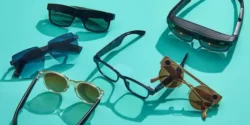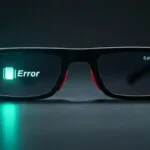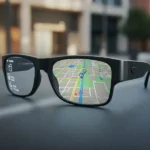Smart Glasses Not Pairing? Here’s How to Fix It (iPhone & Android) 👓📱
Smart glasses offer exciting possibilities for environmental access and augmentative technology and beyond. But frustration can arise when your sleek new eyewear refuses to connect to your iPhone or Android device. Don’t worry, this guide will walk you through troubleshooting common smart glasses not pairing issues and explore the best use cases for smart glasses, with a special focus on EAAT.
Troubleshoot Smart Glasses Not Pairing Problems: A Step-by-Step Guide
Are your smart glasses not pairing with your phone? Let’s get your smart glasses connected! Here’s a systematic approach to resolving pairing issues:
1. The Basics:
- Are they charged? Ensure both your smart glasses and your phone have sufficient battery. A low battery can sometimes interfere with Bluetooth connections.
- Is Bluetooth enabled? Double-check that Bluetooth is turned on for both your iPhone (Settings > Bluetooth) and your Android device (Settings > Connections > Bluetooth or similar).
- Are they in pairing mode? Most smart glasses need to be put into a specific “pairing mode” to be discoverable. Consult your smart glasses’ user manual for instructions on how to activate this mode (it often involves holding down a specific button or combination of buttons for a few seconds).
- Are they close enough? Keep your smart glasses and phone within close proximity (usually within a few feet) during the pairing process.
2. Forget and Re-pair:
Sometimes, a previous pairing attempt might have glitched. Try “forgetting” the device on your phone and then re-pairing:
- iPhone: Go to Settings > Bluetooth. Tap the “i” icon next to your smart glasses’ name (if it appears). Select “Forget This Device” and confirm.
- Android: Go to Settings > Connections > Bluetooth (or similar). Tap the gear icon next to your smart glasses’ name (if it appears). Select “Unpair” or “Forget” and confirm.
Once forgotten, put your smart glasses back into pairing mode and try to connect again through your phone’s Bluetooth settings.
3. Restart Your Devices:
A simple restart can often resolve temporary software glitches that might be causing smart glasses not pairing. Power off and then power on both your smart glasses and your smartphone.
4. Check for Software Updates:
Outdated software on either your smart glasses or your phone can sometimes cause compatibility issues.
- Smart Glasses: Check the manufacturer’s website or companion app for any available firmware updates for your smart glasses. Follow their instructions to update.
- iPhone: Go to Settings > General > Software Update to check for and install any available iOS updates. External Link: Apple Support – Update your iPhone, iPad, or iPod touch
- Android: Go to Settings > System > System update (the exact location may vary depending on your device manufacturer) to check for and install any available Android updates. External Link: Android Help – Check & update your Android version
5. Interference:
Other wireless devices operating on the 2.4 GHz frequency (like Wi-Fi routers, microwaves, and other Bluetooth devices) can sometimes interfere with the pairing process. Try moving to a different location with fewer potential sources of interference.
6. Reset Your Smart Glasses:
Some smart glasses have a reset function that can resolve persistent pairing problems. Consult your user manual for instructions on how to perform a reset. How to Factory Reset Smart Glasses? Step-by-Step
7. Check Compatibility:
Ensure your smart glasses are compatible with your phone’s operating system (iOS version for iPhone, Android version for Android). This information is usually available on the smart glasses manufacturer’s website or in the product specifications.
Best Use Cases for Smart Glasses
Smart glasses are evolving rapidly, offering a range of functionalities. Here are some key use cases, with a focus on their potential:
For Environmental Access and Augmentative Technology:
- Hands-free Information Access: Individuals with physical limitations can access vital information, such as schedules, communication aids, and environmental controls, without needing to use their hands.
- Real-time Communication: Smart glasses with integrated cameras and microphones can facilitate instant communication through video calls or text-to-speech applications, crucial for individuals with speech impairments or those needing remote assistance.
- Navigation and Wayfinding: GPS-enabled smart glasses can provide hands-free directions, aiding individuals with visual impairments or cognitive disabilities in navigating their environment safely and independently.
- Object Recognition and Identification: Some smart glasses can identify objects and provide auditory or visual feedback, assisting individuals with visual impairments in understanding their surroundings.
- Remote Assistance: Caregivers or therapists can remotely view what the smart glasses user sees, providing real-time guidance and support.
- Augmented Reality (AR) for Learning and Task Completion: AR features can overlay visual cues and instructions onto the user’s field of vision, aiding in learning new tasks or following step-by-step processes, beneficial for individuals with cognitive challenges.
Other Notable Use Cases:
- Notifications and Information at a Glance: Receive calls, texts, and app notifications without needing to take out your phone.
- Photography and Videography: Capture hands-free photos and videos of your experiences.
- Fitness Tracking: Monitor activity levels and performance metrics during workouts.
- Entertainment: Enjoy music, podcasts, and even AR games.
- Professional Applications: Industries like manufacturing, healthcare, and logistics are exploring smart glasses for hands-free access to information, remote collaboration, and guided workflows.
Additional Helpful Content
- Consult the User Manual: Your smart glasses’ user manual is the most direct source of information for specific pairing instructions and troubleshooting tips related to your particular model.
- Manufacturer Support: If you continue to experience pairing issues, don’t hesitate to contact the manufacturer’s customer support. They may have specific solutions or be aware of known issues.
- Online Forums and Communities: Online forums and communities dedicated to smart glasses can be valuable resources for finding solutions to common problems and sharing experiences with other users. Search for forums related to your specific brand or model.
FAQ: Common Smart Glasses Not Pairing Questions
Q: Smart Glasses not pairing – Why won’t my smart glasses show up in my phone’s Bluetooth list?
A: Ensure your smart glasses are in pairing mode and that Bluetooth is enabled on your phone. Also, make sure the glasses are close to your phone.
Q: My smart glasses paired but won’t connect. What should I do?
A: Try forgetting the device on your phone and then re-pairing. Restart both your smart glasses and your phone. Check for software updates.
Q: Can I pair my smart glasses with multiple devices simultaneously?
A: Most smart glasses can only be actively connected to one device at a time. You may need to disconnect from one device before pairing with another. Check your user manual for details on multi-device pairing capabilities.
Q: What if my phone says the PIN or pairing code is incorrect?
A: Most modern Bluetooth devices, including smart glasses, use secure simple pairing and don’t require a PIN. If prompted for a PIN, try “0000” or consult your smart glasses’ manual. If the issue persists, try forgetting and re-pairing.
Q: Are smart glasses compatible with all iPhones and Android phones?
A: Compatibility depends on the Bluetooth version supported by both your smart glasses and your phone, as well as the operating system version. Check the manufacturer’s specifications for compatibility information.
By following these troubleshooting steps and understanding the potential of smart glasses, especially within the realm of EAAT, you can unlock the benefits of this exciting technology and enhance independence and access for a wider range of individuals.
Additional helpful information:
How to connect your smart glasses to a phone? How to Connect Smart Glasses to Phone?
Are you have problems charging your smart glasses? Smart Glasses Charging Problems




